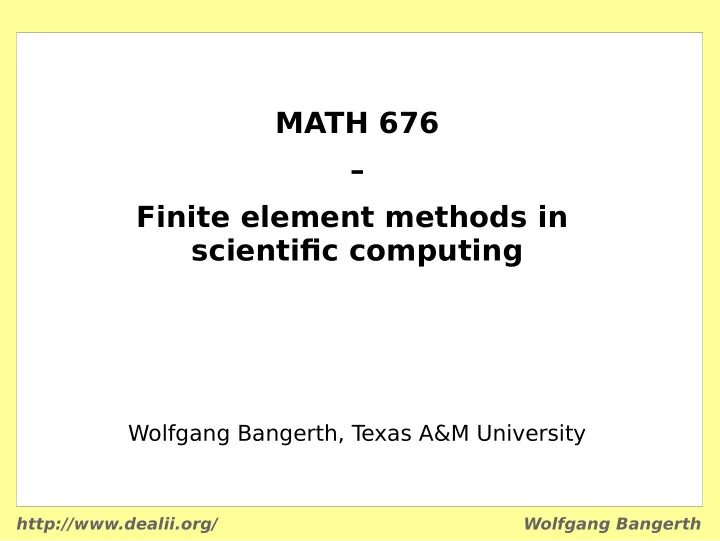

MATH 676 – Finite element methods in scientifjc computing Wolfgang Bangerth, T exas A&M University http://www.dealii.org/ Wolfgang Bangerth
Lecture 2.91: A (very brief) introduction to Linux Part 2: Compiling programs http://www.dealii.org/ Wolfgang Bangerth
Compiling, linking, etc. Building an application is a 2-step process: ● “Compile” every .cc fjle into a .o fjle: c++ -c a.cc -o a.o c++ -c b.cc -o b.o ● “Link” all .o fjles into one executable: c++ a.o b.o -o myprog The details are easier to explain using an example... http://www.dealii.org/ Wolfgang Bangerth
What could go wrong? Both compiling and linking can produce errors: ● Compiler errors: – Your code does not follow the C++ “syntax” – You reference a variable that has not been “declared” – You call a function that has not been “declared” ● Linker errors: – You call a function that has been “declared” but not “implemented” ● Important: When fjguring out what's wrong, need to know which “phase” you're in! http://www.dealii.org/ Wolfgang Bangerth
What could go wrong? Notes on compiler/linker errors: ● Errors often “cascade” → start at the top (i.e., the fjrst error message) ● If there are many error messages, use the command c++ -c a.cc -o a.o 2>&1 | less Here, ' 2>&1 ' “redirects” stderr to stdout, so that it can serve as input to 'less'. ● Linker errors can only happen once everything has been compiled. http://www.dealii.org/ Wolfgang Bangerth
Automating compilation/linking Building an application is a 2-step process: ● “Compile” every .cc fjle into a .o fjle: c++ -c a.cc -o a.o c++ -c b.cc -o b.o ● “Link” all .o fjles into one executable: c++ a.o b.o -o myprog Problem: This is (i) cumbersome to do every time, and (ii) diffjcult to get right with “dependencies”. Solution: Write rules for a program called “ make ”, then say make myprog http://www.dealii.org/ Wolfgang Bangerth
Automating compilation/linking Makefjles contain: ● “targets” – what should be done ● “dependencies” – what does a target depend on ● “rules” – how should a target be created ● Variables and generic rules to make writing rules easier Again: Simpler to to see using a concrete example! http://www.dealii.org/ Wolfgang Bangerth
Automating compilation/linking Makefjles contain: ● “targets” – what should be done ● “dependencies” – what does a target depend on ● “rules” – how should a target be created Problems: ● Simple Makefjles are easy to write ● But quickly become complex and unreadable. Archaic syntax does not help (“make” was invented in 1976). ● Not platform independent ● Not meant as input for tools other than “make” http://www.dealii.org/ Wolfgang Bangerth
Automating compilation/linking Makefjles contain: ● “targets” – what should be done ● “dependencies” – what does a target depend on ● “rules” – how should a target be created Problems: ● … Solutions: There are now tools/programming languages that describe targets, dependencies, and rules at a higher level. They then create Makefjles or other output. Example: autoconf/automake, cmake http://www.dealii.org/ Wolfgang Bangerth
MATH 676 – Finite element methods in scientifjc computing Wolfgang Bangerth, T exas A&M University http://www.dealii.org/ Wolfgang Bangerth
Recommend
More recommend